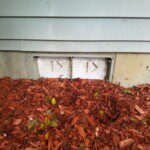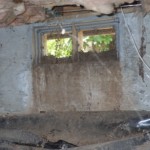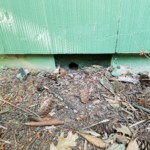The house is winterized:

Most commonly this is done in an effort to protect plumbing from freezing and to keep the floors in the home warmer. What it does instead is cause elevated levels of moisture and radon gas in the crawlspace and in turn – in the home. Does this mean that we support freezing pipes and floors? No. What we support is addressing those legitimate concerns in the appropriate manner. Uninsulated pipes in the crawlspace are at risk of freezing. The solution is to insulate the pipes. Uninsulated floors are both uncomfortable and energy inefficient. The solution is to insulate the floors. Plugging crawlspace vents is not the solution and can cause significant problems including mold growth, wood rot, and elevated radon levels.
(While not removing the requirement for pipes and floors to be insulated, an unvented crawlspace is technically possible and sometimes allowed. However, an unvented crawlspace has to be installed by correctly by a qualified contractor. Removing crawlspace ventilation without the proper precautions to prevent moisture and radon intrusion is a recipe for trouble.)
The Vent is Damaged:
Sometimes we see the homeowner plug a crawlspace vent when the wire mesh inside the vent is damaged. While a plug does help prevent rodent and pest intrusion into the crawlspace, it is not the right answer. The right answer is to repair or replace the damaged mesh.
There is Moisture Intrusion:

Conclusion:
As you can see, there are a number of reasons for crawlspace ventilation to be obstructed. None of the reasons are good. This is why when we see one or more plugged crawlspace vents, we recommend asking the seller to remove all plugs and verify that all vents are intact and in good working order.

